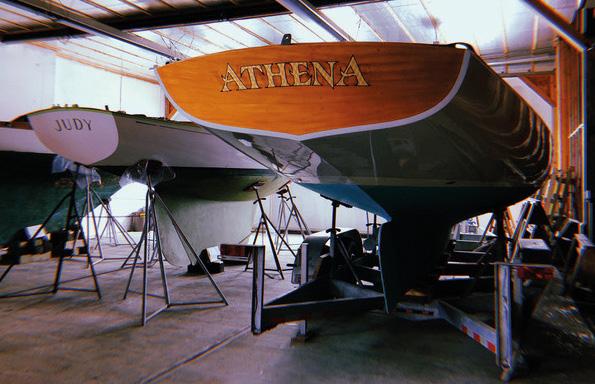
































The 1930 gaffer Wave was in a state of abandonment when her current owner found her, but he took such a liking to the boat that he paid five times the asking – a full £5, no less!
WORDS AND PHOTOS NIGEL SHARP
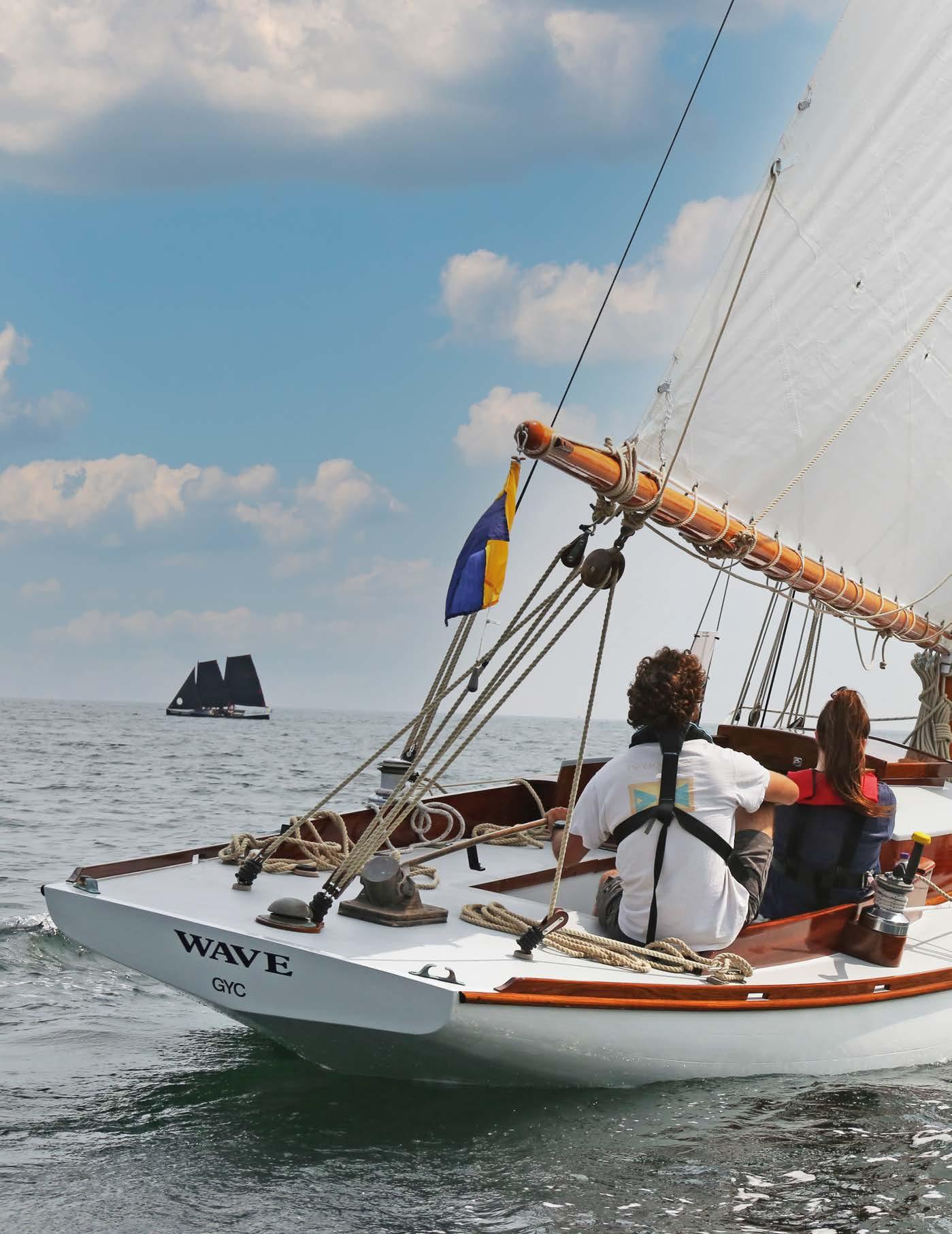
This is the story of a boat whose history, or at least the early part of it, is not entirely certain. Wave’s current owner, Charlie Couture, is 70 per cent sure that she is the same Wave that first appeared in Lloyds Register of Yachts in 1934. She is listed there as having been designed and built in 1930 by PM Coode in Truro, although it is thought that she might actually have been built in the village of Coombe just off the River Fal. Her owner at that time was John Chellew, a resident of Falmouth, although it isn’t clear if he had owned her from new.

Philip Melvill Coode was a solicitor in St Austell but “spent a lot of his time building boats not only for himself but also for other relatives,” Alan Coode, Philip’s great nephew, told me recently. Philip had also designed a 40ft (12.2m) yawl called Skirmish that had been built in Mevagissey in 1902, and he owned Glitter II, a 35ft (10.8m) motorboat which had been built by JL Thorneycroft in 1930 and would later take part in the evacuation of Dunkirk. Rather strangely, from 1936 Lloyds Register attributes the design and build of Wave to WD Coode, Philip’s cousin Walter Damarell Coode who was a civil engineer.
The following year Wave was sold to Alan Dale-Harris, a member of the Little Ship Club and St Mawes SC.
Charlie Couture’s Wave was bought, as far as we know, by Henry E Marquand and taken over to Guernsey in the late 1930s, so if she is the same boat as the Coode Wave then this may have coincided with Dale-Harris’s purchase of the WE Thomas-built 40ft cutter Anolis in 1939. The only reference to Wave in Lloyds Register after that is in the Change of Ownership section in the 1946 Supplement (the first Lloyds publication since 1939) which merely says “sold”.
Soon after the German occupation of the Channel Islands began at the end of June 1940, Wave’s stern was damaged when she was hit by a German patrol boat. She was also moved – along with many other privately owned vessels which were supposedly in the way – from St Peter Port to St Sampson which is where she remained, on a drying mooring, for the remainder of the war.

Perfect conditions meant max speed for the classics at the 16th Vela Puig, as the city prepares for the America’s Cup
WORDS STEFFAN MEYRIC HUGHES PHOTOS NICO MARTINEZ/PUIG

As the Med regattas go, the Puig in Barcelona still seems like an outlier compared to its longer established cousins like Voiles de Saint-Tropez, Cannes or Monaco, sitting as it does further to the west. Quietly though, it’s become rather a big deal in the 18 years since it was first run under its long-term sponsor, the Spanishowned fashion giant Puig. It regularly attracts around 50 yachts, and those who know it love the regatta for its location in the Catalonian capital of Barcelona, one of the world’s great cities, and for one other thing too: the great Barcelonian breeze, which nearly always guarantees good racing.



This year, while much of the rest of Europe broiled under 45-degree sun, every day was a perfect 30 with a good 15kts of steady ocean breeze. Topless women paraded the long, sandy beach leading to the docks, and locals glided by quietly on electric skateboards and scooters. The calisthenics crowd, all young, brown and muscled, performed impossible looking moves on the pull-up bars to a dirty stream of splintered beats and abrupt shouts from their portable speaker, and parasols billowed gently outside the endless cafes, restaurants and bars. In the docks, there was a quieter sense of excitement, as among the lovely old dock buildings, some covered in fishing nets and nearly all quietly sinking into a life of comfortable decrepitude, new, temporary-looking metal sheds were springing up, the famous names of Britannia, Alinghi and more, emblazoned across their fronts. The big news is that the 37th America’s Cup is coming to the Catalonian capital next year, and most of the teams are already in town, setting down roots to spend the next 12 months in training for this, sailing’s biggest event.



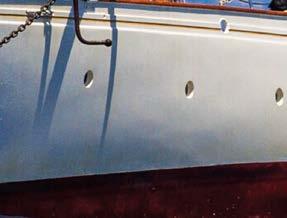



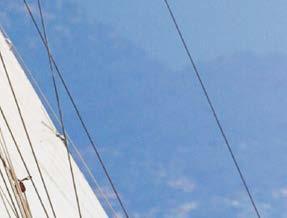

















This is a flying visit to Barcelona, so to see most of the action, I head out with Spanish photographer Nico Martinez and driver Carlos in a RIB, bouncing over some sizeable swell and getting drenched to the skin, to catch up with our fleet of 47 yachts, which are all pressed into a steady heel by the 13 knots of steady southern breeze… the Garbi, as it’s known here… and making for the windward mark before running off seven miles or so to the north, following the city’s coastline. After a series of wild rides, where we weaved in and out of the fleet in close proximity for Nico to get the shots he needed, we quickly bolted down our packed lunches provided by the sponsor – some very good ham sandwiches and a pasta salad – while we rocked to the swell, re-applying sun cream – “you need this, contra the sunburst,” someone from the Puig team had warned earlier.
It seemed as if the bay had filled with every iteration of sail under speed from history. On this little patch of sea, under those perfect conditions, we saw a small brigantine making a steady 6 knots, pulling her whole body through the water at hull speed. In the classics fleet, there was an IOR class for the first time, numbering three yachts, and a spirit-of-tradition class, also for the first time, and also numbering three yachts – a Spirit 37, which would emerge the clear winner, and two Leonardo 44s. These represented the next great leap, to separate fin and skeg-hung rudder, with broader hull forms sitting a little higher on the water. A catamaran race taking place played totem to the multihulls like Crossbow that held the world sailing speed record from its inception in 1972 until
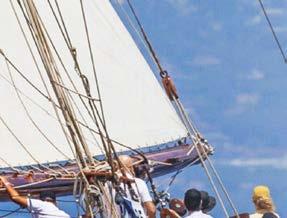
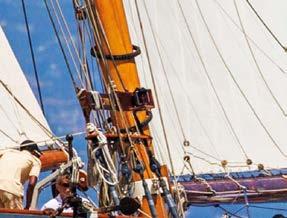



I’ve done it at the top of a mast, I’ve done it on the end of a bowsprit, I’ve done it underwater, I’ve done it while being courted by an amorous seal, and now I’ve done it on the bow of a 19ft (5.8m) speedboat crossing Southampton Water at 20kts. I am of course talking about taking photos. Part of my job as boating journalist is to wedge myself in various awkward positions to hopefully get what is known in the trade as ‘the money shot’. What I hadn’t anticipated when I climbed onto the foredeck of the Sabre 19 was how little space there would be. I had to either slide back onto the windscreen or perch with the bow cleat between my legs. I chose the latter as it gave me the wide-angle view I was after. But ouch.
I was lucky it was a calm day on Southampton Water with hardly any other boats around, and hence very little wash. Despite my extra weight in the bow, the little boat carried on as if nothing had changed (though I’m sure driver Robert Grundy must have
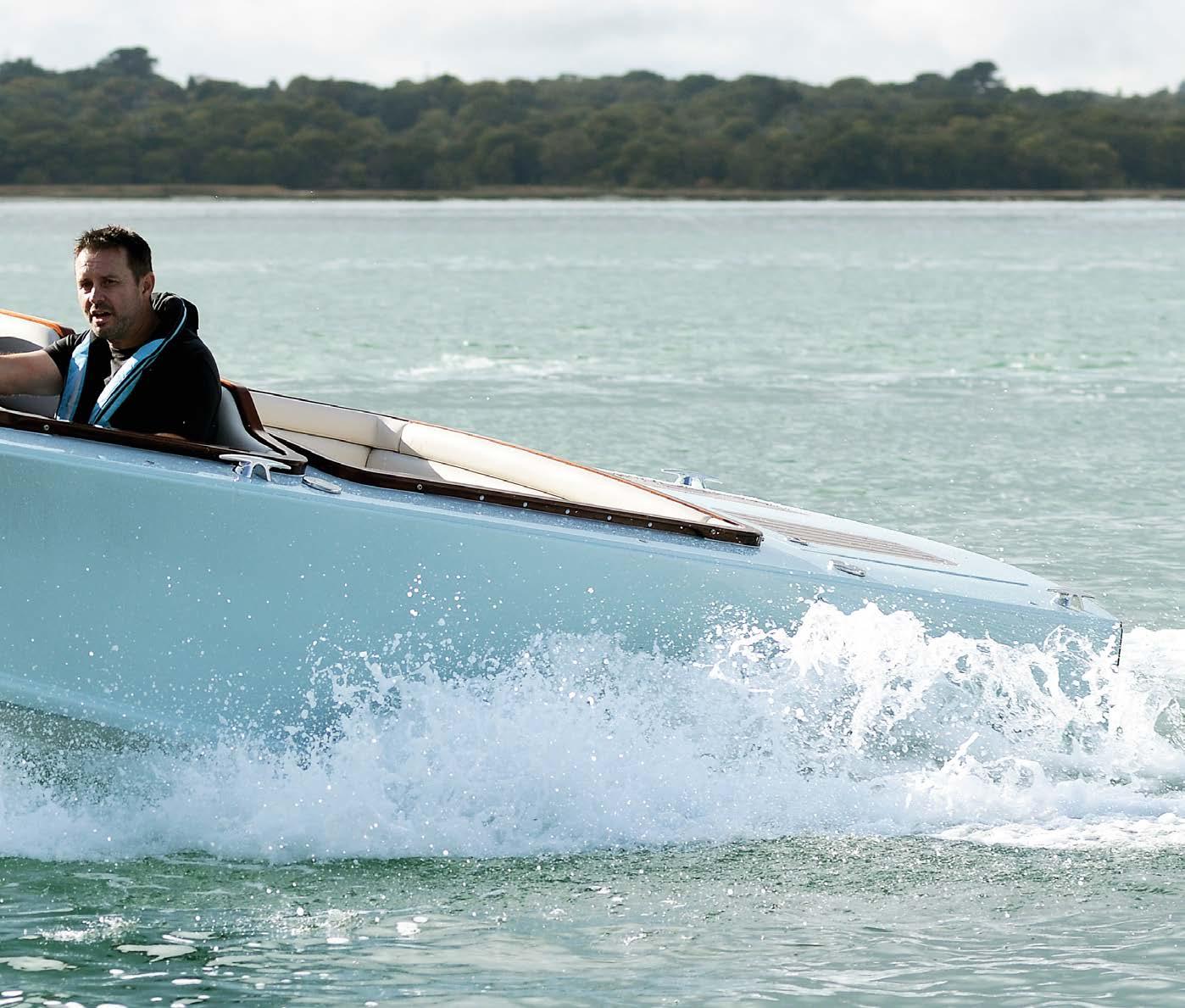
trimmed the stern drive) and gave me a surprisingly comfortable ride. Not only that, but my camera stayed completely dry this time. Thanks Robert.
I had first seen the Sabre 19 at the Southampton Boat Show last year. I was initially drawn to her because of all those compound curves – going from that bold flare in the bow to the sexy tumblehome in the stern. It seemed an awful lot to pack into such a small shape, and yet it looked fantastic. And then I saw her builders: Fairey Marine. To most classic boat aficionados, Fairey Marine holds a special place as the builders of an iconic range of boats, mostly designed by Uffa Fox, ranging from the 12ft (3.7m) Firefly to the 15ft Flying 15 (4.6m) and the 31ft (9.5m) Atalanta. In the late 1950s, the company branched out into building motorboats – mainly the Huntresses, Huntsmen and Swordfish of various denominations – which soon acquired a devoted following. To this day, an original Fairey Marine motorboat is something of a collector’s item.

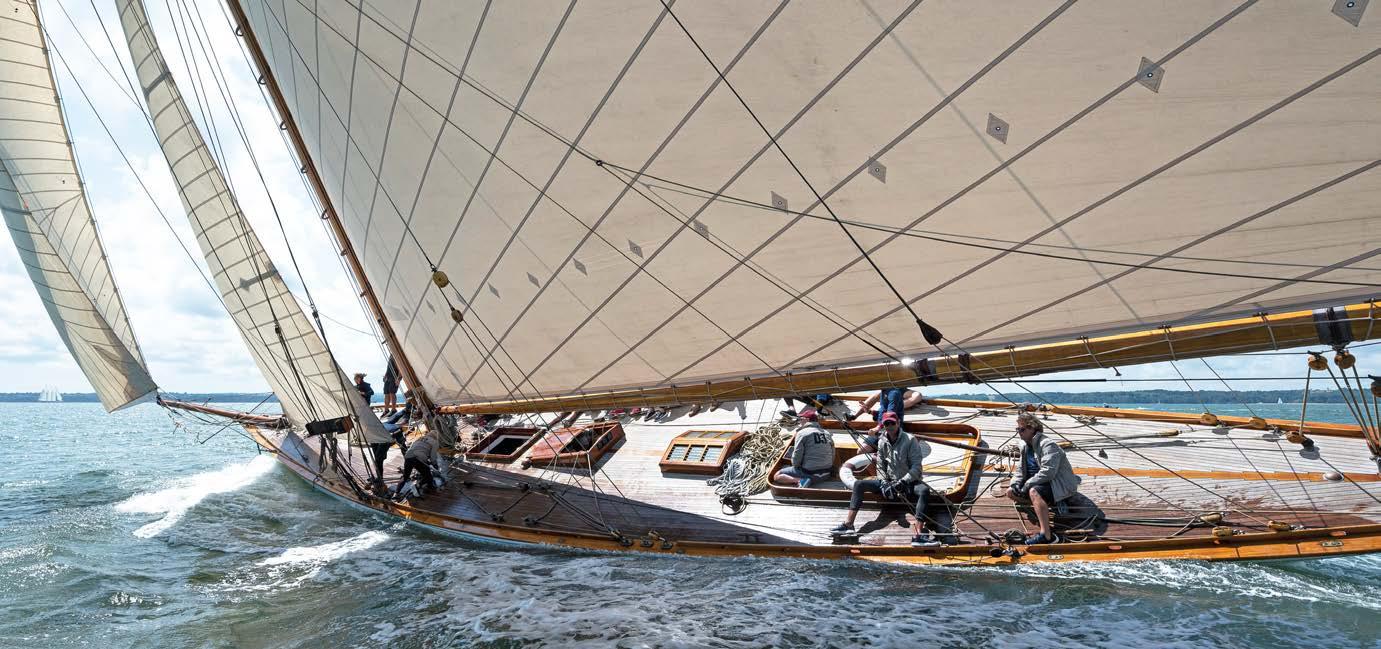 WORDS BY KATHY MANSFIELD
WORDS BY KATHY MANSFIELD
All classic boats that race in the top Mediterranean regattas know the CIM, the Comite International de la Mediterranée, which lays down the rules for the boats that race in its regattas. Dealing with not just dimensions but also materials, heritage and history, rulings can inevitably be controversial and passionately discussed and debated, but if a team wishes to race in the regattas the CIM oversees, it must abide by the CIM decisions.
Many owners enjoy racing their yachts with friends and family, to celebrate their longevity, innovation and beauty, and consider themselves stewards of these treasures that will later be handed on to someone else to preserve. Many stay in the same family through generations. They research the history of their boats, their design and build and their previous owners. The boats are restored and maintained with respect to their materials, history and capabilities, sometimes with the benefit of modern technologies such as glues or metals but not necessarily in order to achieve ever faster racing
Above: Racing under CIM rules at the Richard Mille Cup this summer Facing page: Voiles de Saint-Tropez – part of the Mediterranean Championship
results; the boats can be severely damaged by pushing them too hard. So there is a tension here, a dichotomy between two valid passions: to celebrate the boats and also to win the races. This needs to be resolved, or at least acknowledged, hence the need or a common authority.
After the Fife Regatta in Scotland in 2022, some of the fleet raced in the Solent under CIM rules, and they were used again for the Richard Mille Cup this summer, as the boats raced from Falmouth in Cornwall to Dartmouth, the Solent and across the Channel. This looks to be a major new advance in coming years. It’s important for classic boat owners who might want to race their boats to be aware of new developments at CIM.
Renaud Godhard, secretary general of the CIM, explained the history of the Comite International de la Mediterranée. The CIM was initiated back in 1926 when some of these same boats were being enthusiastically raced, and regulation was even then seen to be needed. Boats such as Moonbeam III (then named Eblis) were winning races then as now. The presidents of the Yacht
This yard, like the others here often featured in the magazine over the years, is situated at the head of Vineyard Haven Harbor on the island of Martha’s Vineyard. After 42 years in business, it is a well-established operation focused on the design, construction, restoration, and maintenance of wooden boats. Gannon and Benjamin boats have a reputation for sound construction and simplicity; they are nimble and handsome. The Gannon and Benjamin boatyard is a vital part of our historic waterfront, and has built over 75 boats to its designs, as well as
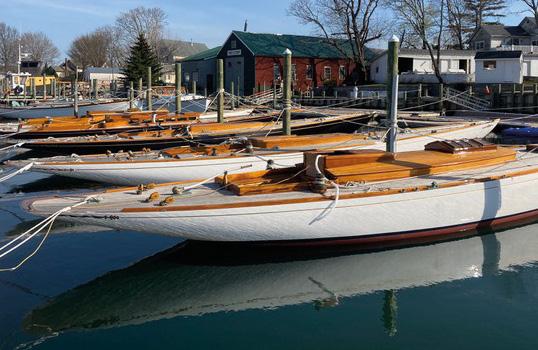
restoring many classics for customers around the world. The team of shipwrights, riggers, metal fabricators and painters are passionate about their work, and the yard often take on apprentices to pass on these traditional skills. This winter the boatyard will be restoring a Sam Crocker ketch and a Herreshoff S-Class as well as building a new vessel: Design Number 100, a 26ft gaff sloop daysailer with an electric auxiliary drive. These are alongside the annual maintenance for more than 30 wooden boats, most built by G&B. See gannonandbenjamin.com.


Wooden Boatworks will be familiar to many readers, with a string of high-profile restorations and new-builds over the years. It’s a fullservice wooden boatyard specialising in the build, restoration, and care of plank-on-frame yachts. Located at the historic Hanff’s Boatyard in Greenport, NY, in the shelter of Stirling Harbor, current owners Patrick Brennan and Steve Lubitz take pride in carrying on the boatbuilding legacy of Ketcham, Hanff, Koch, Costello, and most recently, Donn Costanzo and Bruce Wahl. It’s a yard with a busy
winter maintenance schedule of mostly local boats, but that hasn’t stopped it building some of the most arresting projects of recent years, including the builds of two identical Fife III-designed 8-M yachts – Invader and Defender. Fife’s 1930 design was brought back to life in 2015 and again in 2017. Other well-known restorations have included the 1926 Alfred Mylne yacht Chicane and the 1930 Mylne The Blue Peter. The yard is no stranger to power either, as the rebuild of the 41ft Bunker and Ellis motor yacht Tartan from 1953 proves. The distinctive ring of caulking irons and the smells of wood shavings, hemp & pine tar continue to emanate from the yard today.
